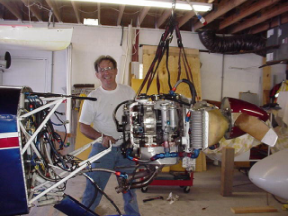Prelude to this engine removal. I had recently (10
hours previous) rebuilt my rotary engine after it had
swallowed an apex seal. I flew down to visit Tracy Crook
at Shady Bend and several other rotary lovers were there
also. After taking the cowl off, I was showing how the
Mustang 65MM Throttle body on my engine was rigged to
fully open. Afterwards as it was getting dark, we
adjourned to Tracy's house to an excellent rotary dinner
prepared by Laura and spend the night.

The next morning arrived bright and a bit cool, just
a great day for flying a rotary. So Tracy, Finn and I
decided to fire up the girls and go for a flight. The
first thing that happend to me was when I fired up the
engine, it immediately rev to high rpm - yeah, the dummy
had forgotten to close the throttle after the demo of
the preceeding evening and we all know how quickly the
rotary can rev. Well, my lighten quick reflex chopped
throttle before it got past 5000 rpm, so all is good.
We three then decided to proceed with the take off
and flight. Now Tracy and Finn decided that rather than
taxi to the far end of the runway, that given the very
slight breeze, they both elected to take off down wind.
Well, my bird was a bit heavier and I just never, never
liked taking off downwind. So as Tracy and Finn soared
overhead, I was taxing to the far end of the runway.
While taxing I noticed my oil pressure was hovering
around 20-25 psi. Humm, I thought a bit on the low side
(normally at idle the pressure was around 60 psi), but
told myself the engine was still cold and the oil a bit
sluggist. But, even when I reved the engine the oil
pressure stayed below 30 psi.
Well, I couldn't stand it. I aborted the decision to
launch and slowly taxied back down to Tracy's hangar.
On Tracys returned we discuss possible causes including
faulty sensor/gauge, impeded oil flow, and others.
Well, everything seem to check out OK. But, I just
couldn't leave it at that. That little uneasy feeling
just wouldn't go away.
So decided to take the engine off. To do that
because of my plugs-up engine orientation, i have to
take off the sidemount oil pan. well as I removed the
last oil pan bolt and pulled the oil pan away from the
engine I heard a metalic clank inside the oil pan.
Further examination revealed a chunk of metal in the
shape of a cresent moon - Ah ha! the light bulb comes on
that looks like a woodruff key!
It turns out that during my reassembly after the
rebuild that when I pushed the spocked oil pump Gear on
its shaft, I apparently pushed the woodruff key out of
its slot and into the oil pan. Now I did put plenty of
torque on the tightening nut and apparaently that is
what I had been flying with for the last 10 hours.
However, the rapid rpm increase on that cold morning
with the heavy oil apparently broke the torque hold of
the nut and the sprocket was slowly slipping on the
shaft producing some oil pressure but not what was
needed and would have probably stopped producing any
pressure with a little it more turning and wearing on
the shaft.
Who knows how long the nut torque would have held had
I not accidently reveved up the engine on that old
morning or where it may have failed. Made me shudder
thinking about my flights over the Georgia Okefenokee 500,000 acre swamp. As
I write this I happened to look on my office wall
where there is an "Award" from Real World Solutions
(Tracy and Laural Crook).
This award is titled "Lightening
Strikes Six times (or More) Award presented to Ed
Anderson for Discovering the most unlikely failure
modes in rotary powered aicraft, including (but not
Limited to):
Hung flop tube-fuel Starvation,
Spontaneous fuel combusion (open gas tank refuling on
cold dry morning), Oil pump key drop out, Ballast coil
resistor failure in ignition module, Tire shredding
wheel pant Hardware, busted brakeline oil fire
(destorying tire and wheel pant), etc,. But, never
was any of these problems the fault of the engine
itself.
So be careful folks, your guardian
angle might not be as proficient as mine was 